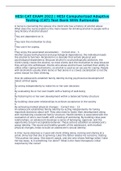-
1. Exam (elaborations) - Hesi cat exam 2022 latest update
-
2. Exam (elaborations) - Hesi computerized adaptive testing (cat) test bank with rationales |hesi cat exam 202...
-
3. Summary - Hesi terminology
-
4. Exam (elaborations) - Cat hesi exit 3 exam - questions with answers
-
5. Exam (elaborations) - Hesi cat 2022 exam - questions and answers
-
6. Exam (elaborations) - Hesi exit 2022 - cat exam 1 – questions and answers
-
7. Exam (elaborations) - Hesi comprehensive exam 2022 - questions and answers
-
8. Exam (elaborations) - Hesi comprehensive exam 3 – questions and answers
-
9. Exam (elaborations) - Hesi critical care exit - questions and answers
-
10. Exam (elaborations) - Hesi critical care 2022 questions and answers
-
11. Exam (elaborations) - Hesi critical care 2022 questions and verified answers
-
12. Exam (elaborations) - Hesi exit rn v3 2022 (160 questions and answers)
-
13. Exam (elaborations) - Hesi exit rn v2 2021 questions and answers
-
14. Exam (elaborations) - Hesi exam - 160 questions and answers (2020-2021)
-
15. Exam (elaborations) - All hesi exit qbank / ati exams test bank questions and answers
-
16. Exam (elaborations) - Hesi exit exam 2 (1-147 questions and answers)
-
17. Exam (elaborations) - Hesi exit exam 3 – (201-300 questions and answers)
-
18. Exam (elaborations) - Hesi exit questions with complete solutions
-
19. Exam (elaborations) - Hesi exit exam 2022/study guide
-
20. Exam (elaborations) - Hesi rn mental health 2019 v1-v3 all combined
-
21. Exam (elaborations) - Pediatrics hesi exam 2022 - questions and answers
-
22. Exam (elaborations) - Pediatric exam hesi (latest update) questions and answers
-
23. Exam (elaborations) - Hesi exit exam 2022
-
24. Exam (elaborations) - Hesi final exam 2022 questions and answers
-
25. Exam (elaborations) - Hesi med surg 2020 v1 exit exam (200 questions and all correct answers)
-
26. Exam (elaborations) - Hesi med surg exit exam v1 2022 questions with answers
-
27. Exam (elaborations) - Pediatrics hesi pn review (q & a with rationales)
-
28. Exam (elaborations) - Hesi pediatric pn specialty v2 / pediatric hesi exam 2021
-
29. Exam (elaborations) - Hesi pn practice exam – questions and verified answers
-
30. Exam (elaborations) - Nur4311 hesi exit rn exam v3 2022 (new)
-
31. Exam (elaborations) - Hesi exit rn exam v1-v7 2021 updated - scored 100%
-
32. Exam (elaborations) - hesi exit rn v1 exam 2022 actual test - questions and answers 100% correct
-
33. Exam (elaborations) - Hesi advanced pathophysiolog y fnp v1 100 2019 - questions and answers
-
34. Exam (elaborations) - Hesi exit final exams family nurse practitioner
-
35. Exam (elaborations) - Hesi dosage calculation - assignment and practice exam
-
36. Exam (elaborations) - Hesi med surg questions & answers ( newly revised,2020) (answers verified 100% correc...
-
37. Exam (elaborations) - Hesi qbank - maternity hesi 1 testbank 2020 / hesi 2016, 2017, 2018, 2019, 2020 & 202...
-
38. Exam (elaborations) - Hesi rn cat exam 2022 v1&v2 questions and answers
-
39. Exam (elaborations) - Hesi rn comprehensive exit exam v2-2021 actual exam
-
40. Exam (elaborations) - Hesi review qbank | hesi pn exit exam v1,v2,v3,v4, v5 &v6 all combined - 2022 update
-
41. Exam (elaborations) - Hesi exit exam latest update questions and answers with rationales
-
42. Exam (elaborations) - Hesi exit prep test bank - questions and answers
-
43. Exam (elaborations) - Hesi rn exit exam 2021 - questions and answers
-
44. Exam (elaborations) - Rn exit hesi (2020) questions and answers
-
45. Exam (elaborations) - Hesi mental health rn v1, v2 & v3 year 2020-2022
-
46. Exam (elaborations) - Hesi mental health 2022 questions and answers
-
47. Exam (elaborations) - Fundamentals hesi |221 questions and answers
-
48. Exam (elaborations) - Hesi a2 biology practice questions and answers
-
49. Exam (elaborations) - Hesi health assessment exam - questions and answers
-
50. Exam (elaborations) - Gerontology hesi practice exam | 50 questions and answers
-
51. Exam (elaborations) - Gerontology hesi practice exam | 99 questions and answers
-
52. Exam (elaborations) - Qbank - med surg hesi practice - questions and answers
-
53. Exam (elaborations) - Hesi comprehensive exit exam | 132 questions and answers
-
54. Exam (elaborations) - Hesi rn exit exam | 150 questions and answers
-
Show more




